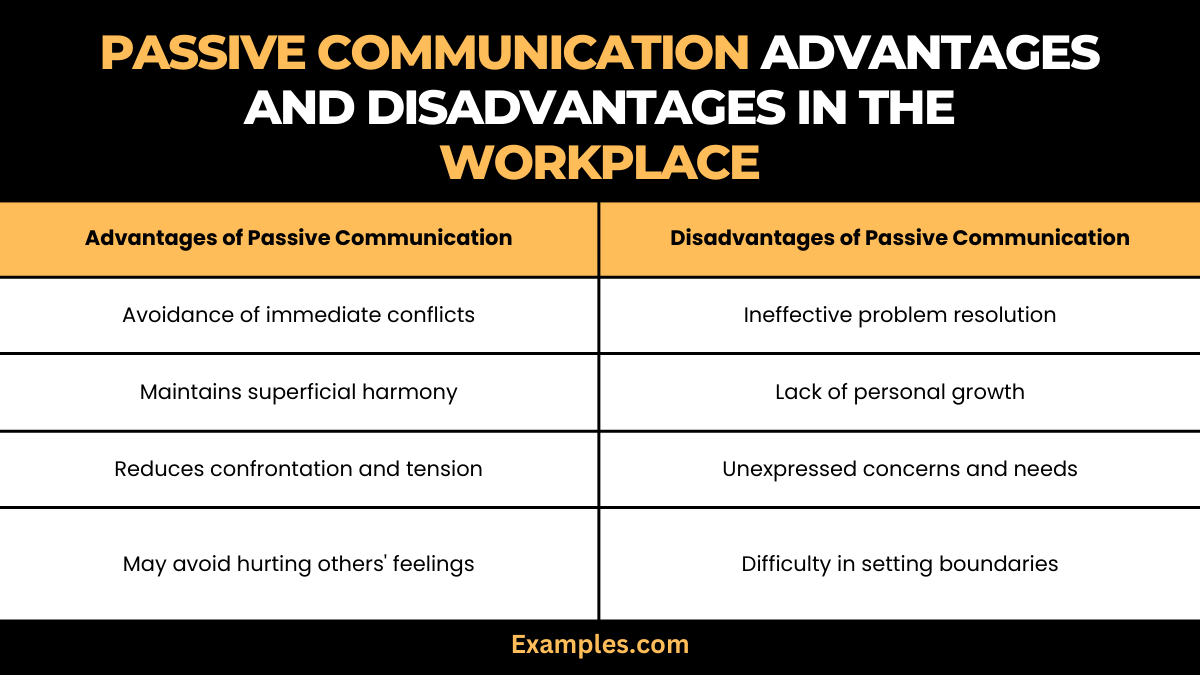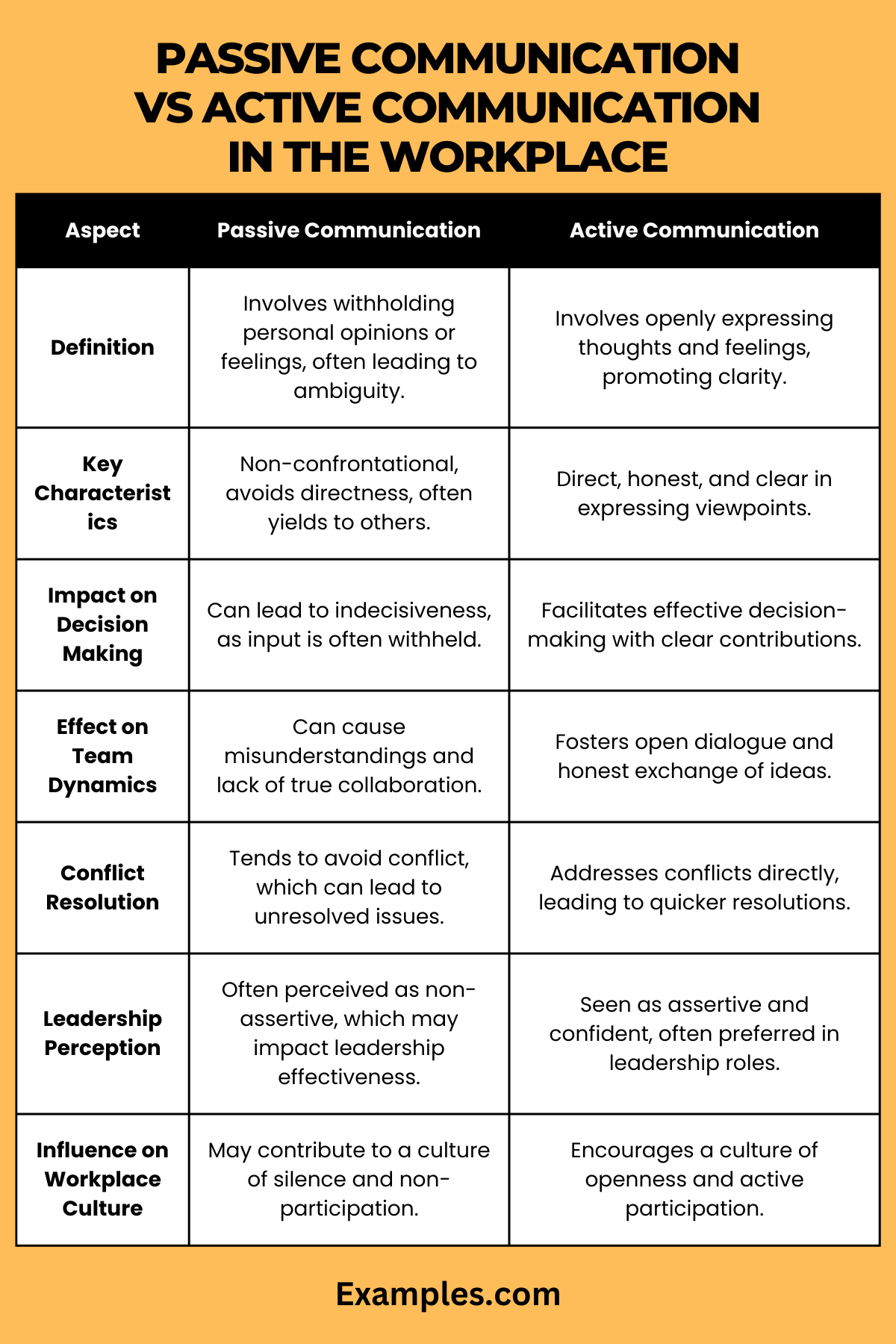49+ Passive Communication in the Workplace Examples
Embark on a journey through the realms of Passive Communication in the Workplace with this all-encompassing guide. This resource is rich in Passive Communication Examples, offering a deep dive into the subtle nuances of non-assertive interactions. Understand the significance of this communication style, its influence on team dynamics, and its practical application in everyday work scenarios. Enhance your knowledge and skills in recognizing and effectively managing passive communication to foster a more collaborative and understanding workplace environment.
What is Passive Communication in the Workplace? – Definition
Passive Communication in the Workplace refers to a communication style where individuals tend to avoid direct or assertive expression of their thoughts, feelings, or needs. This approach is characterized by a tendency to yield to others, often at the expense of one’s own preferences or requirements. In such a setting, individuals may refrain from offering opinions, resist asserting themselves, or choose not to respond to situations that require a decisive stance. This communication style can significantly affect workplace dynamics, often leading to misunderstandings and reduced team effectiveness. Key related concepts include Characteristics of Passive Communication and Signs of Passive Communication, which help in identifying and understanding this communication pattern in a professional environment.
50 Examples of Passive Communication in the Workplace

Passive Communication in the workplace is a subtle yet impactful behavior pattern. It involves minimizing one’s presence or opinions, potentially leading to challenges in effective team collaboration. These instances are crucial for recognizing and managing passive behaviors to improve communication dynamics. Relevant keywords include “Passive Communication Styles” and “Passive Communication Situations,” offering further insight into this communication approach.
- Agreeing to tasks without enthusiasm: Often saying yes to assignments without genuine willingness.
Example: “I guess I can do that if no one else is available.” - Indirectly asking for help: Hinting at needing assistance instead of asking directly.
Example: “It’s tough to manage this alone, but I’ll try.” - Avoiding eye contact during conversations: Demonstrating disengagement or lack of confidence.
Example: Speaking while looking away or down. - Using qualifying phrases excessively: Diminishing one’s own statements.
Example: “I’m not sure, but maybe we could try this approach.” - Failing to express disagreement: Not voicing dissent to maintain harmony.
Example: “I don’t mind, whatever the team decides is fine.” - Rarely initiating conversations: Waiting for others to start discussions.
Example: Staying silent in meetings unless directly addressed. - Apologizing frequently and unnecessarily: Over-apologizing, even when not at fault.
Example: “Sorry, but could I possibly add something?” - Speaking softly or hesitantly: Conveying uncertainty or reluctance.
Example: “I think, um, we might consider looking into this?” - Deferring decisions to others: Shifting responsibility to avoid making choices.
Example: “I don’t mind, what do you think we should do?” - Using passive voice in emails: Obscuring the subject in written communication.
Example: “The report was completed late due to unforeseen circumstances.” - Overusing ‘I think’ and ‘maybe’: Indicating uncertainty in one’s opinions.
Example: “I think maybe we could try a different method, but I’m not sure.” - Not asserting personal needs or preferences: Sacrificing personal interests for others.
Example: “I’ll just go along with what the team wants.” - Allowing interruptions without objection: Not asserting oneself in conversations.
Example: Stopping mid-sentence when interrupted and not continuing. - Expressing opinions as questions: Phrasing statements uncertainly.
Example: “Don’t you think it might be better to delay the project?” - Avoiding confrontation even when necessary: Stepping back in conflict situations.
Example: “It’s not a big deal, let’s just forget about it.” - Seeking constant reassurance: Needing affirmation for decisions.
Example: “Do you think I did this right? I’m not sure.” - Preferring written over verbal communication: Avoiding direct interaction.
Example: Sending an email rather than having a face-to-face conversation. - Minimizing accomplishments or skills: Underplaying personal achievements.
Example: “It was nothing special, anyone could have done it.” - Expressing needs indirectly through sighs or gestures: Communicating dissatisfaction non-verbally.
Example: Sighing heavily when overloaded with work. - Being overly concerned with pleasing others: Prioritizing others’ needs excessively.
Example: “If it makes everyone else happy, I’m okay with it.” - Not sharing ideas in meetings: Staying silent even when having valuable input.
Example: Remaining quiet despite having a potential solution. - Responding with ‘I don’t know’ frequently: Avoiding taking a stand.
Example: “I don’t know, what do you think we should do?” - Saying ‘it’s fine’ when it’s not: Masking true feelings to avoid conflict.
Example: “It’s fine, we can go with that plan.” - Refraining from asking for clarifications: Not seeking information to avoid seeming uninformed.
Example: Nodding along even when not fully understanding. - Using phrases like ‘just’ or ‘only’ to downplay statements: Diminishing the importance of one’s words.
Example: “I just wanted to suggest that maybe we could consider a different approach.” - Not advocating for oneself during evaluations or promotions: Failing to highlight one’s own achievements.
Example: “I guess I did okay this year, but I’m sure others did better.” - Giving in to peer pressure easily: Succumbing to group opinions without resistance.
Example: “If everyone else thinks it’s a good idea, then I guess it’s okay.” - Showing reluctance to lead projects or teams: Avoiding leadership roles.
Example: “I don’t think I’m the best person to lead this.” - Avoiding giving feedback or opinions: Not sharing constructive criticism.
Example: “Whatever you think is best, I don’t have a strong opinion.” - Expressing uncertainty about one’s own ideas: Downplaying one’s own suggestions.
Example: “I had an idea, but it’s probably not that good.” - Preferring to follow rather than initiate changes: Hesitating to propose new initiatives.
Example: “I’ll just wait and see what others think about changing the process.” - Using self-deprecating humor: Making oneself the butt of jokes to deflect attention.
Example: “I’m probably the last person who should be handling this, but I’ll give it a try.” - Offering help without being asked and neglecting one’s own tasks: Prioritizing others’ needs over personal responsibilities.
Example: “I can help you with that, even though I have my own work to do.” - Waiting for others to notice one’s needs: Not voicing personal requirements.
Example: Silently hoping someone will notice the need for assistance. - Avoiding asking for raises or promotions: Not expressing career aspirations.
Example: “I don’t think it’s the right time for me to ask for a raise.” - Showing reluctance to share personal views or beliefs: Keeping opinions private to avoid disagreement.
Example: “I’d rather not say what I think about this issue.” - Preferring not to be the center of attention: Shying away from the spotlight.
Example: “I don’t need to present, someone else can do it.” - Rarely challenging or questioning decisions: Accepting decisions without input.
Example: “If that’s what’s been decided, then it must be for the best.” - Expressing agreement even when unsure: Agreeing for the sake of agreement.
Example: “Sure, that sounds good to me, I guess.” - Not expressing dissatisfaction or discomfort: Bearing discomfort without complaint.
Example: “It’s a bit of a stretch for me, but I can manage.” - Being overly accommodating in scheduling or planning: Giving up personal preferences easily.
Example: “Whenever is good for you works for me too.” - Downplaying problems or issues that arise: Minimizing the severity of challenges.
Example: “It’s a small issue, nothing to worry about really.” - Avoiding direct answers, preferring vague responses: Giving non-committal answers.
Example: “Well, it could go either way, I suppose.” - Lacking assertiveness in group discussions: Not speaking up in meetings.
Example: “I don’t really have anything to add here.” - Preferring to blend in rather than stand out: Avoiding drawing attention to oneself.
Example: “I’m fine just working in the background.” - Hesitating to share achievements or successes: Underplaying one’s accomplishments.
Example: “It was a team effort, I didn’t do much.” - Avoiding asking for constructive feedback: Not seeking improvement opportunities.
Example: “I’m sure I’m doing fine, no need for feedback.” - Showing reluctance to take credit for positive outcomes: Sharing credit even when primarily responsible.
Example: “It was all thanks to the team, not just me.” - Preferring not to engage in debates or discussions: Staying out of potentially contentious conversations.
Example: “I don’t have much to say on this topic.” - Overly deferring to authority or seniority: Not questioning decisions from higher-ups.
Example: “If management thinks it’s right, then it must be.”
What are the Passive Communication Styles in the Workplace
Understanding different “Passive Communication Styles in the Workplace” is crucial for enhancing workplace dynamics. These styles, often marked by non-assertiveness and indirectness, can significantly impact team interactions and individual performance.
- Indirect Communication: This involves conveying messages in a roundabout way, leading to possible misinterpretations and unclear outcomes. It’s a common style where the communicator avoids direct confrontation.
- Submissive Communication: Individuals adopting this style consistently agree with others, neglecting their own opinions. This can result in a lack of representation of diverse viewpoints, affecting team decision-making.
- Avoidant Communication: This style is characterized by steering clear of potentially uncomfortable topics or situations. It often leads to unresolved issues and a lack of closure in workplace discussions.
- Non-confrontational Communication: Individuals avoid conflict at any cost, leading to suppressed feelings and a lack of honest dialogue. This can hinder the development of effective “Passive Communication Skills.”
- Minimal Verbal Contribution: Involves contributing very little to conversations, which can be perceived as a lack of interest or engagement, affecting team morale and collaboration.
Each of these styles has distinct implications in a professional setting, highlighting the importance of recognizing and addressing passive communication behaviors for better team functionality.
Passive Communication Advantages and Disadvantages in the Workplace

The “Advantages & Disadvantages of Passive Communication” in the workplace present a complex picture. While passive communication can maintain surface-level peace, it often leads to deeper issues in team dynamics and individual well-being.
Advantages:
- Reduces Immediate Conflict: It temporarily prevents confrontations, maintaining a superficial harmony that can be beneficial in highly tense situations.
- Perceived as Diplomatic: Sometimes, this approach is seen as diplomatic or accommodating, potentially beneficial in maintaining certain workplace relationships.
Disadvantages:
- Leads to Misunderstandings and Conflicts: The lack of clarity and assertiveness often results in misunderstandings, leading to long-term conflicts and unresolved issues.
- Internal Resentment and Stress: Continuous suppression of thoughts and feelings can lead to internal resentment, affecting job satisfaction and mental health.
- Ineffective Decision-Making and Problem-Solving: The absence of diverse viewpoints and honest feedback can impair decision-making processes and creative problem-solving in teams.
Balancing the pros and cons of passive communication can be challenging, but it is essential for creating a healthy and productive workplace environment.
Passive Communication vs Active Communication in the Workplace

The contrast between “Passive Communication vs Active Communication in the Workplace” highlights significant differences in the effectiveness and impact of these communication styles.
| Aspect | Passive Communication | Active Communication |
|---|---|---|
| Definition | Involves withholding personal opinions or feelings, often leading to ambiguity. | Involves openly expressing thoughts and feelings, promoting clarity. |
| Key Characteristics | Non-confrontational, avoids directness, often yields to others. | Direct, honest, and clear in expressing viewpoints. |
| Impact on Decision Making | Can lead to indecisiveness, as input is often withheld. | Facilitates effective decision-making with clear contributions. |
| Effect on Team Dynamics | Can cause misunderstandings and lack of true collaboration. | Fosters open dialogue and honest exchange of ideas. |
| Conflict Resolution | Tends to avoid conflict, which can lead to unresolved issues. | Addresses conflicts directly, leading to quicker resolutions. |
| Leadership Perception | Often perceived as non-assertive, which may impact leadership effectiveness. | Seen as assertive and confident, often preferred in leadership roles. |
| Influence on Workplace Culture | May contribute to a culture of silence and non-participation. | Encourages a culture of openness and active participation. |
| Communication Efficacy | Less effective in expressing needs and ideas, leading to potential unmet goals. | More effective in articulating needs and ideas, leading to goal fulfillment. |
- Passive Communication: This style is characterized by a lack of directness in expressing thoughts and feelings. It can lead to ambiguity, causing “Passive Communication Situations” where important issues are left unaddressed. While it might avoid immediate conflict, it often results in missed opportunities for constructive dialogue and problem-solving.
- Active Communication: Involves expressing oneself clearly and directly. This style fosters transparency and encourages open dialogue, crucial for “Effective Workplace Communication.” Active communicators are often seen as more confident and reliable, contributing positively to team dynamics and decision-making.
Understanding the differences between these styles is vital. Incorporating more active communication techniques in a predominantly passive environment can lead to more engaged and productive interactions, enhancing overall workplace effectiveness. Balancing these styles, depending on the situation, can lead to a more harmonious and efficient workplace.
To further enhance your understanding and skills in effective workplace communication, consider exploring additional resources such as Asana’s guide on “12 Tips for Effective Communication in the Workplace” and Penn State Extension’s article on “Effective Communication in the Workplace.
In conclusion, understanding and managing “Passive Communication in the Workplace” is vital for a healthy, productive work environment. This guide has provided insights into various passive communication styles, their impacts, and how they compare with active communication. By applying these tips and strategies, individuals and teams can enhance their interactions, leading to improved collaboration, decision-making, and overall workplace harmony.



